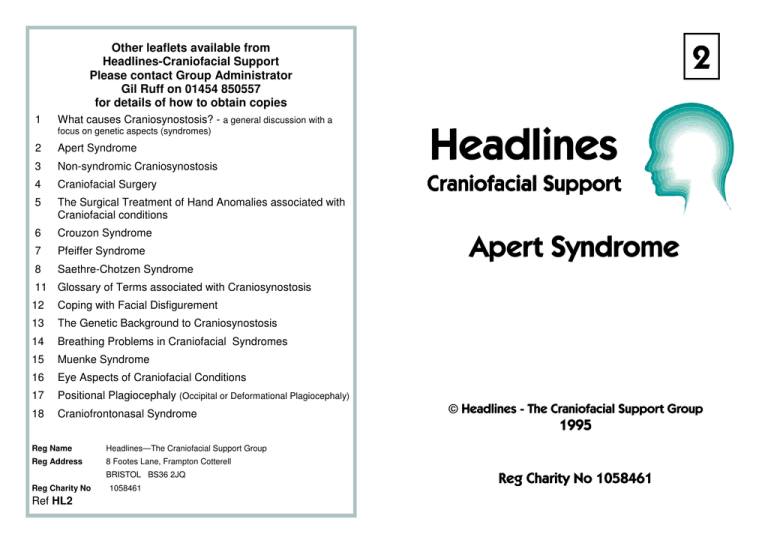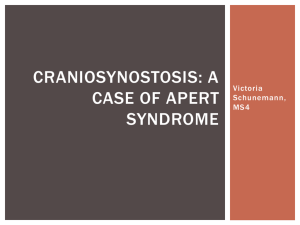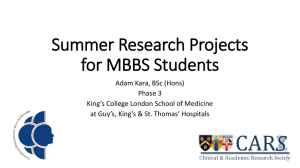Apert Syndrome
advertisement

Other leaflets available from Headlines-Craniofacial Support Please contact Group Administrator Gil Ruff on 01454 850557 for details of how to obtain copies 1 2 What causes Craniosynostosis? - a general discussion with a 2 Apert Syndrome 3 Non-syndromic Craniosynostosis Headlines 4 Craniofacial Surgery Craniofacial Support 5 The Surgical Treatment of Hand Anomalies associated with Craniofacial conditions 6 Crouzon Syndrome 7 Pfeiffer Syndrome 8 Saethre-Chotzen Syndrome focus on genetic aspects (syndromes) Apert Syndrome 11 Glossary of Terms associated with Craniosynostosis 12 Coping with Facial Disfigurement 13 The Genetic Background to Craniosynostosis 14 Breathing Problems in Craniofacial Syndromes 15 Muenke Syndrome 16 Eye Aspects of Craniofacial Conditions 17 Positional Plagiocephaly (Occipital or Deformational Plagiocephaly) 18 Craniofrontonasal Syndrome Reg Name Headlines—The Craniofacial Support Group Reg Address 8 Footes Lane, Frampton Cotterell BRISTOL BS36 2JQ Reg Charity No Ref HL2 1058461 Headlines - The Craniofacial Support Group 1995 Reg Charity No 1058461 This leaflet has been written by Mr Steven Wall Consultant Plastic Surgeon Oxford Craniofacial Unit Radcliffe Infirmary Oxford orbital advancement and remodelling". An added advantage of this procedure is improvement of the shape of the brow and enlargement of the orbits with improved protection of the eyes. The timing of this procedure is determined by the severity and rate of progression of the condition. It is most frequently performed at, or before, one year of age. The small midface is generally treated later on in life by moving bone segments of the face forward by a procedure known as a "Le Fort III osteotomy". In severe cases this may be performed simultaneously with a forehead advancement and is a procedure known as a "monobloc advancement". In some cases it may be necessary to move the orbits closer together by a procedure known as a "facial bipartition". The exact timing and nature of these types of procedures are determined by the severity and rate of progression of each individual case and should be discussed in detail with your treating team. (For more information see Headlines leaflet Craniofacial Surgery). It is important to note that this condition is an abnormality in the growth potential of various areas of the skull and face. Surgery may correct established changes and release some growth potential, but cannot restore the overall growth to normal. Recurrence of the synostosis and failure of adequate growth makes the need for repeat procedures quite common. The planned long term management programme should be discussed in detail with the treating team. Introduction Apert's syndrome is one of the craniofacial conditions which fits in to the group called craniofacial dysostosis syndromes. It was first described in the early 1900's by the French paediatrician Eugene Apert. It has a number of distinct features involving the cranium, face and limbs. As a result it has also been classified as acrocephalosyndactyly type 1. The disorder occurs about 1 in every 65,000 live births. It arises as a result of a change in one of the genes on chromosome 10. This gene codes for the activity of the so-called fibroblast growth factor receptor 2 (FGFR 2). The "fibroblast growth factors" are chemicals produced by a number of different cells throughout the body and have a variety of effects on the growth, multiplication and maturation of various cells. These effects ore moderated by the so-called fibroblast growth factor receptors. These receptors ore present on various cells including many in the craniofacial sutures and limbs amongst others. It is the change in the activity of these receptors arising from the genetic abnormality and the resultant effect on the associated cells which results in a number of features typical of Apert's syndrome and related conditions. If the genetic abnormality is present, then an affected individual has a 1 in 2 chance of passing this on to their children. However, the vast majority of Apert's syndrome cases arise as a new mutation or change from unaffected parents. The child with Apert's syndrome Apert's syndrome presents with a number of typical features, the most important of which are craniosynostosis, mid-face hyperplasia, exorbitism and syndactyly. Craniosynostosis means the premature fusion or closure of the growth lines, or sutures, of the skull (and face). The number and sites of fusion ore very variable and the severity and rate of 6 3 progression of the craniofacial features' are determined by the number and exact sites involved. Typically at least two transverse, or control, sutures ore involved and a variable number of those in the skull base and face. Fusion of the sutures decreases the ability of the bone to grow at the affected sites and results in growth by compensation at unaffected sutures. The combination of growth failure and compensation leads to typical shapes and appearances. The skull in Apert's patients tend to be short from front to back and relatively broad - condition referred to descriptively as brachycephaly. If sufficient number of sutures are involved or the process is extremely severe then the growth of the skull may be out-stripped by the growth of the brain and the condition of raised intracranial pressure, that is increased within the skull, may arise (this will be discussed later). As a result of abnormal growth of the base of the skull, the orbits, or bony boxes, around the eyes tend to be relatively shallow causing the eyes to bulge and in severe cases cause problems with closure of the eyelids. This condition is known as exorbitism and in severe cases may constitute an indication for urgent operation (see later). The midface may be affected to variable degrees. It is generally small and fails to grow adequately. This condition of midfacial hypoplasia may result in a small or constricted airway and the appearance of a relatively large lower jaw. The resultant airway problems may result in breathing difficulty for the more severely affected children. 4 The term syndactyly refers to fusion of the fingers and toes which is typical of children with Apert's syndrome. This may consist of three grades, varying from fusion of the central three digits to complete fusion of the bones and nails of all five digits. (This aspect of Apert's syndrome will not be covered further in this leaflet - see Headlines leaflet Hand Anomalies Associated with Craniofacial Conditions.) Likewise limitation of movements of the shoulders and elbows can occur. A number of children with Apert's syndrome present with a cleft palate and this will also not be covered in more detail here. Surgical treatment The treatment in Apert's syndrome is aimed at three areas: 1. The relief of raised intracranial pressure, if present, or steps to prevent it if severe ostosis is present. 2. The attempted correction of exorbitism and protection of exposed eyes as an early step, if indicated. 3. The prevention of progressive distortion and the correction of established features, if possible. Surgical management of airway problems may also be required in severe cases. In some cases raised pressure in the skull may be a result of changes in the flow of the fluids surrounding and filling the cavities within the brain - a condition known as hydrocephalus. If this is present then diversion of the fluid by a procedure known as a "shunt" may be necessary. In general, raised intracranial pressure and changes in calvarial shape are treated by enlarging the skull and changing the overall shape by releasing and moving segments of the skull in appropriate areas. This is most commonly in the area of the forehead and orbits by a procedure which is known as a "fronto 5


